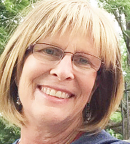
I have to hope that as my cancer becomes resistant to my current treatment regimen, other drugs will come along to push it back again.— Anne Jacobs
Tweet this quote
I’ve always had fibrocystic breasts and was steadfast in performing monthly breast self-exams, so I could become familiar with the terrain of my breasts and spot any subtle changes. So, in November 2002, when I felt something in my left breast that seemed different from my usual lumps, I made a mental note of it and carefully checked the area again in December; I was relieved that the lump seemed to be gone.
The following month, however, the lump was back, and I made an appointment with my gynecologist, who ordered a mammogram, which didn’t turn up anything suspicious. But a subsequent ultrasound detected not just the lump I had been feeling but several other questionable tumors as well. Within days, I was sent for a biopsy of the suspicious tissue, and by then, I could feel another small lump in the upper part of the same breast. Whatever this was, it was multiplying quickly.
Although I was concerned that new tumors seemed to be appearing overnight and knew that couldn’t be a good sign, it was still shocking to get the phone call from my gynecologist with the news I had breast cancer and urging me to make an appointment with a surgeon right away.
I was just 42 and had 3 young sons, ages 11, 5, and 3. I desperately wanted to be around for them for as long as I could, so even though the cancer appeared confined to my left breast, I made the decision to have a contralateral prophylactic mastectomy and don’t regret it. Although my right breast was healthy, the pathology report showed there were five cancerous tumors in my diseased breast. The diagnosis was stage III estrogen receptor– and progesterone receptor–positive and HER2/neu-positive breast cancer.
Learning to Live With Chronic Cancer
After healing from the surgery, I met with an oncologist, who although extremely capable didn’t instill a lot of confidence in me, and I asked to see another oncologist. I believe the decision saved my life. My second oncologist recommended what was considered at the time an aggressive course of a combination regimen of doxorubicin and cyclophosphamide; by the time I was finished with the six rounds of chemotherapy, I was convinced I was cured and could put cancer behind me. I was wrong.
A few months later, I started experiencing back pain, and an x-ray showed the cancer had metastasized to my left hip and L5 vertebra. I thought I was going to die. Getting through my initial cancer diagnosis was difficult, but hearing that my cancer, while still treatable, was now incurable was terrifying. Even now, 12 years later, it is still difficult for me to cope with having chronic cancer, and my life has been completely upended.
I’m grateful that therapies such as trastuzumab (Herceptin) and ado-trastuzumab emtansine (Kadcyla), and now combinations of paclitaxel, pertuzumab (Perjeta), and trastuzumab, plus localized radiation have managed to keep me a step ahead of the cancer advancing out of control, but I don’t know how much longer it will remain contained. I have to hope that as my cancer becomes resistant to my current treatment regimen, other drugs will come along to push it back again. But my life never ceases to be a series of highs and lows, depending on the result of my latest magnetic resonance imaging (MRI) or positron-emission tomography (PET) scans, and making a plan for a vacation or even a visit with my mother a few months or even weeks in advance is out of the question.
A Matter of Perception
When I first learned I had metastatic disease, one oncologist told me that although my cancer would never be cured, it could be treated as a chronic disease. While my husband, Chris, heard hope in her words, I heard a death sentence and have had to recalibrate how I view and live my life, trying not to project too far into the future. Still, I can’t help but feel a sense of panic, especially around the time of my next imaging appointment and the words I expect to someday hear: “There is nothing more we can do for you.”
To tamp down the fear, I try to concentrate on the things in my life I can control, and I’m grateful for a supportive medical team, a loving family, and wonderful friends to help me through the tough days and celebrate the good ones. It really does take a village to live with cancer, and I’m glad I don’t have to face this disease alone.
I try to keep a positive attitude and stay focused on the immediate days before me. I’m grateful to be alive, and although I live my life one day at a time, I have continued hope that I will be around to see what the long-term future holds for me. ■
Ms. Jacobs lives in Gold River, California.

